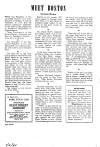
Click to enlarge.
Home Page Meet Boston Menu Index
|
MEET BOSTON Friday, Jan. 10, 1941 in What's New In Town W. J. Sidis |
The first President of the United States was John Hancock of Boston. It was as President, in 1776, that his famous signature appeared at the head of the signatures to America’s Declaration of Independence.
Three Presidents of the United States―Hancock and the two Presidents Adams―were born in Quincy.
*
The President of the Hawaiian Republic, in fact, was descended from a Boston family, still to be found in Jamaica Plain.
*
Old tales tell of the time a ship captain named Nix was found dead on his vessel in Boston Harbor The ship’s mate, who had been known to be jealous of the captain, was taken to one of the islands near the harbor entrance and hastily tried for murder. He was hanged, though protesting his innocence to the last, and his last words were praying that, as witness that he was innocent, the island would wither away. Shortly after that, the island began to sink, till only a few rocks were left.
The island is now known as Nix’s Mate.
*
Boston is not merely 200 miles nearer to Europe than New York, it is also about a hundred miles nearer to all ports on the east coast of South America.
*
On Canal Street, opposite the freight sheds, was a row of hay and grain establishments. The municipal hay scales, set up in 1852, were removed only a few years ago to make room for a new traffic circle. Hence the name Haymarket Square.
*
In the days when the Eastern Mass. trolley cars (formerly the “Bay State” system) went into Brattle Subway Station, before the rebuilding of the bridge between Charleston and Chelsea, there was a sign at the trolley loop at North Station that always puzzled tourists going thereabouts. It read something like this:
“Boston Elevated transfers are not good on Bay State cars. Take Boston Elevated surface-subway cars.”
*
Anyone remember the old days, with little white trolley cars labeled “U.S. Mail” wandering all over the place―and stopping on special mail-car tracks on Dartmouth Street, where the Back Bay Postoffice was then located where there is now a Walton lunch room?
―When no less than 18 car lines, to various suburban regions, blocked Boylston Street traffic, and a troop of starters were kept on the hop, handing out transfers to passengers getting off cars where Mass. Station is now. (Sometimes passengers had to hustle all round the crossing to find the starter and, as he never knew who came off a car and who did not, it was easy to get a transfer when you had not had a ride.)
*
There are still a few left of the signs that used to be so plentiful on Boston’s rapid transit lines, reading “Danger―Third Rail Alive.”
Considering how New York keeps insinuating that Bostonians always use fancy language and long words, it may be interesting to see how much simpler such a sign would be around the Island City. A corresponding sign, seen in Newark, N.J., reads: “CAUTION―All persons are warned against danger of contact with electrified third rail.”
*
Boston is the only city having a “citizen alarm” on its police boxes – enabling anyone to summon police aid in much the same way as a fire alarm can be rung in.
WE’RE SORRY
In Mr. Marmor’s column in Vol. V. January 3, 1941, Issue 1, the paragraph regarding density of population should correctly read, “There are 995 streets on Manhattan Island. There are 997 streets in Dorchester alone . . . Massachusetts has more people per square mile than any other state except Rhode Island and New Jersey. According to the census of 1930, Somerville had more people per square mile than any other American city of over 100,000 population.”